Developing Individuals, Teams, and Organisations in Harrods Store
VerifiedAdded on 2024/05/14
|26
|5331
|408
Report
AI Summary
This report examines the employee development programs at Harrods, focusing on skills, behavior, and attitude analysis. It discusses the use of Continuous Professional Development (CPD) and Myers-Briggs tests to assess employee traits. The report highlights the differences between individual and organizational learning, emphasizing the need for continuous learning to drive sustainable business performance. It also explores the application of High-Performance Work (HPW) practices within Harrods, evaluating different approaches to performance management and their impact on fostering a high-performance work culture and commitment. The analysis includes the use of SWOT analysis and Richard Step questionnaires to identify employee strengths and weaknesses, leading to the development of professional development plans aimed at aligning individual growth with organizational goals.
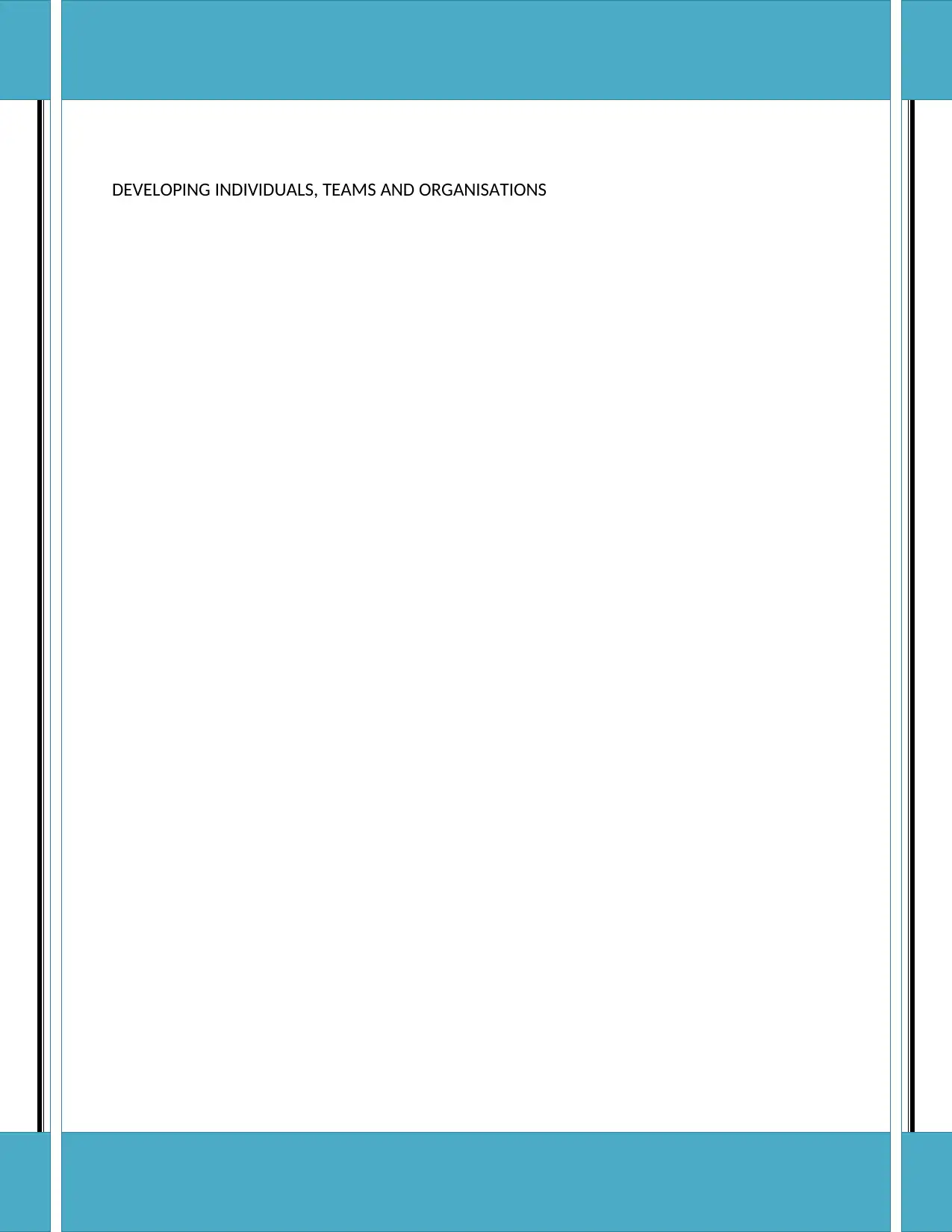
DEVELOPING INDIVIDUALS, TEAMS AND ORGANISATIONS
Paraphrase This Document
Need a fresh take? Get an instant paraphrase of this document with our AI Paraphraser
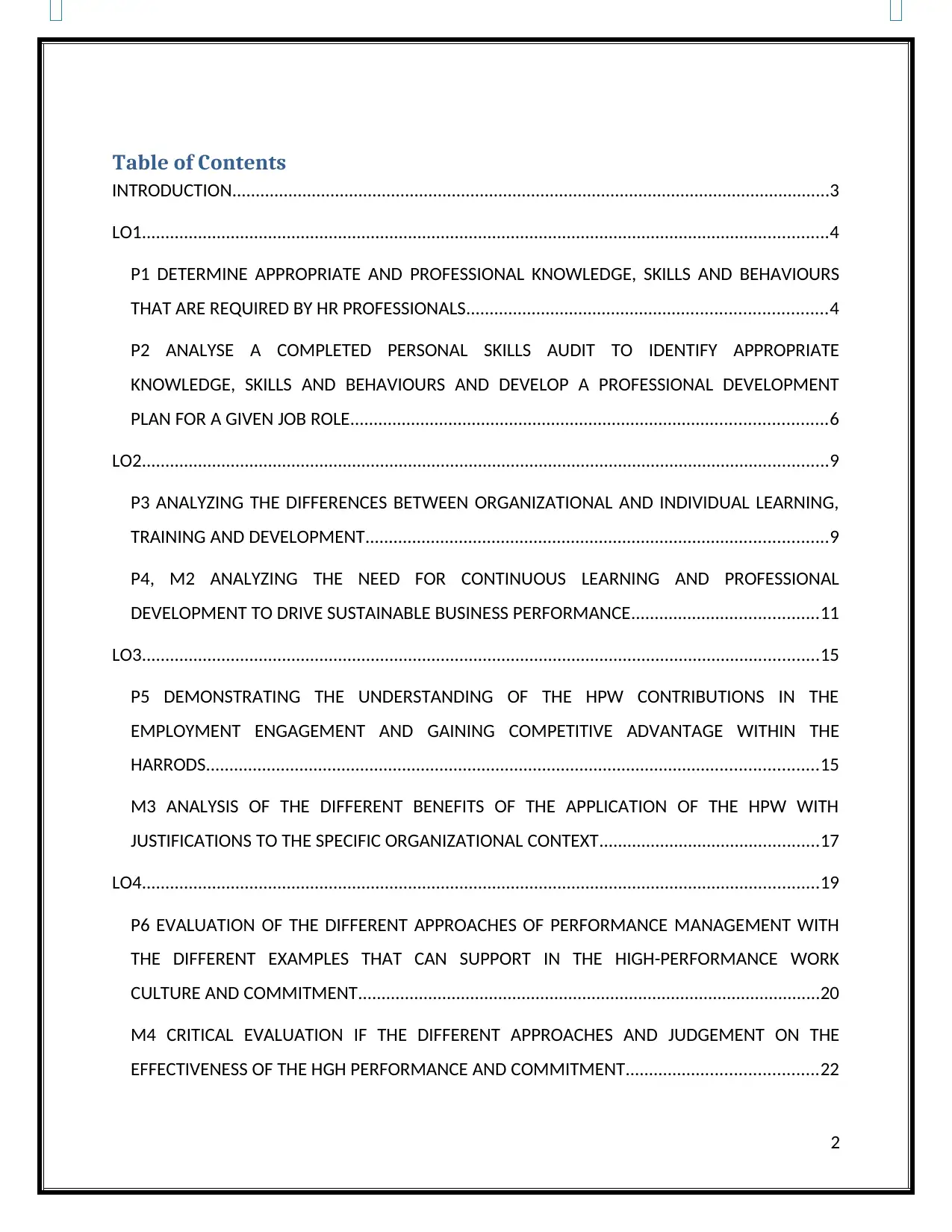
Table of Contents
INTRODUCTION................................................................................................................................3
LO1...................................................................................................................................................4
P1 DETERMINE APPROPRIATE AND PROFESSIONAL KNOWLEDGE, SKILLS AND BEHAVIOURS
THAT ARE REQUIRED BY HR PROFESSIONALS.............................................................................4
P2 ANALYSE A COMPLETED PERSONAL SKILLS AUDIT TO IDENTIFY APPROPRIATE
KNOWLEDGE, SKILLS AND BEHAVIOURS AND DEVELOP A PROFESSIONAL DEVELOPMENT
PLAN FOR A GIVEN JOB ROLE......................................................................................................6
LO2...................................................................................................................................................9
P3 ANALYZING THE DIFFERENCES BETWEEN ORGANIZATIONAL AND INDIVIDUAL LEARNING,
TRAINING AND DEVELOPMENT...................................................................................................9
P4, M2 ANALYZING THE NEED FOR CONTINUOUS LEARNING AND PROFESSIONAL
DEVELOPMENT TO DRIVE SUSTAINABLE BUSINESS PERFORMANCE........................................11
LO3.................................................................................................................................................15
P5 DEMONSTRATING THE UNDERSTANDING OF THE HPW CONTRIBUTIONS IN THE
EMPLOYMENT ENGAGEMENT AND GAINING COMPETITIVE ADVANTAGE WITHIN THE
HARRODS...................................................................................................................................15
M3 ANALYSIS OF THE DIFFERENT BENEFITS OF THE APPLICATION OF THE HPW WITH
JUSTIFICATIONS TO THE SPECIFIC ORGANIZATIONAL CONTEXT...............................................17
LO4.................................................................................................................................................19
P6 EVALUATION OF THE DIFFERENT APPROACHES OF PERFORMANCE MANAGEMENT WITH
THE DIFFERENT EXAMPLES THAT CAN SUPPORT IN THE HIGH-PERFORMANCE WORK
CULTURE AND COMMITMENT...................................................................................................20
M4 CRITICAL EVALUATION IF THE DIFFERENT APPROACHES AND JUDGEMENT ON THE
EFFECTIVENESS OF THE HGH PERFORMANCE AND COMMITMENT.........................................22
2
INTRODUCTION................................................................................................................................3
LO1...................................................................................................................................................4
P1 DETERMINE APPROPRIATE AND PROFESSIONAL KNOWLEDGE, SKILLS AND BEHAVIOURS
THAT ARE REQUIRED BY HR PROFESSIONALS.............................................................................4
P2 ANALYSE A COMPLETED PERSONAL SKILLS AUDIT TO IDENTIFY APPROPRIATE
KNOWLEDGE, SKILLS AND BEHAVIOURS AND DEVELOP A PROFESSIONAL DEVELOPMENT
PLAN FOR A GIVEN JOB ROLE......................................................................................................6
LO2...................................................................................................................................................9
P3 ANALYZING THE DIFFERENCES BETWEEN ORGANIZATIONAL AND INDIVIDUAL LEARNING,
TRAINING AND DEVELOPMENT...................................................................................................9
P4, M2 ANALYZING THE NEED FOR CONTINUOUS LEARNING AND PROFESSIONAL
DEVELOPMENT TO DRIVE SUSTAINABLE BUSINESS PERFORMANCE........................................11
LO3.................................................................................................................................................15
P5 DEMONSTRATING THE UNDERSTANDING OF THE HPW CONTRIBUTIONS IN THE
EMPLOYMENT ENGAGEMENT AND GAINING COMPETITIVE ADVANTAGE WITHIN THE
HARRODS...................................................................................................................................15
M3 ANALYSIS OF THE DIFFERENT BENEFITS OF THE APPLICATION OF THE HPW WITH
JUSTIFICATIONS TO THE SPECIFIC ORGANIZATIONAL CONTEXT...............................................17
LO4.................................................................................................................................................19
P6 EVALUATION OF THE DIFFERENT APPROACHES OF PERFORMANCE MANAGEMENT WITH
THE DIFFERENT EXAMPLES THAT CAN SUPPORT IN THE HIGH-PERFORMANCE WORK
CULTURE AND COMMITMENT...................................................................................................20
M4 CRITICAL EVALUATION IF THE DIFFERENT APPROACHES AND JUDGEMENT ON THE
EFFECTIVENESS OF THE HGH PERFORMANCE AND COMMITMENT.........................................22
2
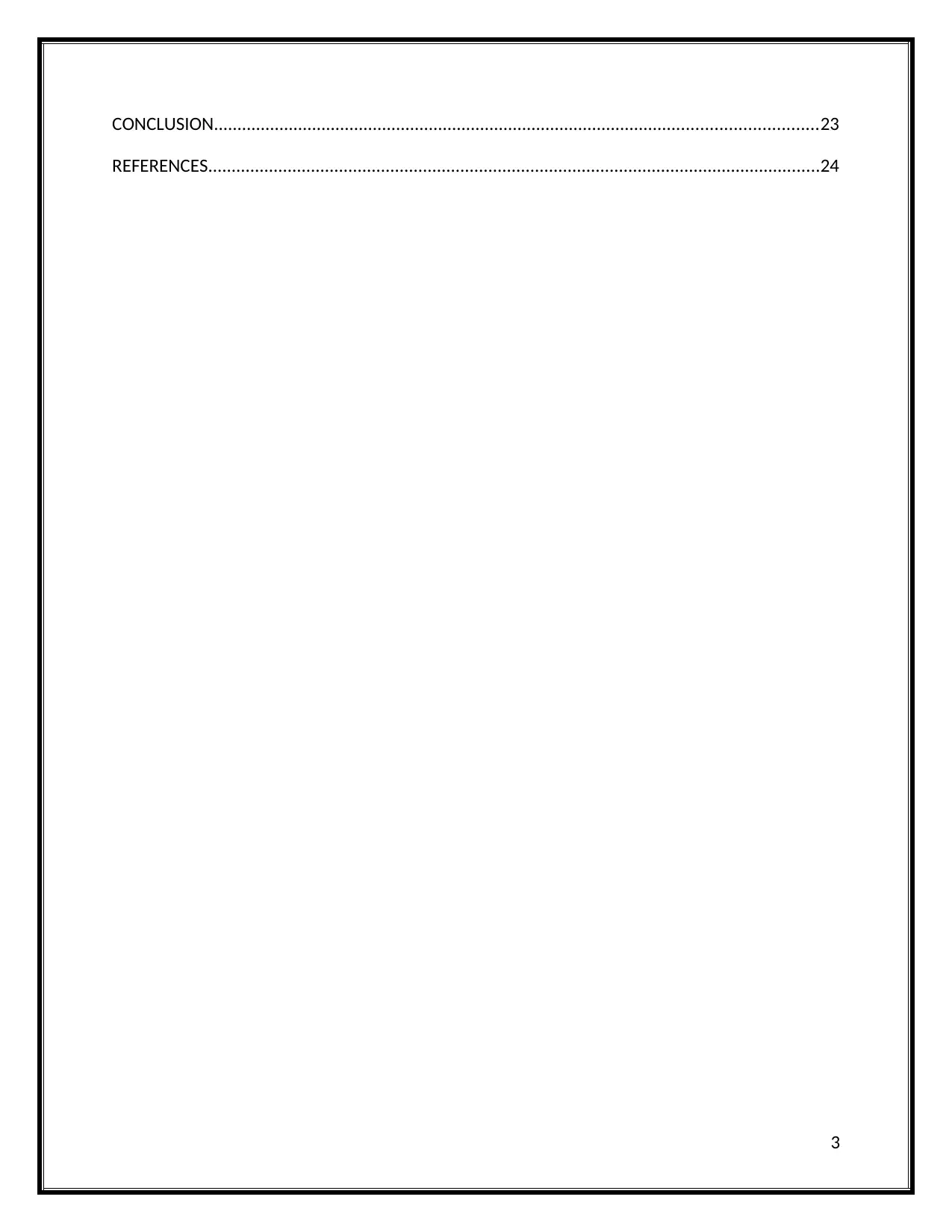
CONCLUSION.................................................................................................................................23
REFERENCES...................................................................................................................................24
3
REFERENCES...................................................................................................................................24
3
⊘ This is a preview!⊘
Do you want full access?
Subscribe today to unlock all pages.

Trusted by 1+ million students worldwide
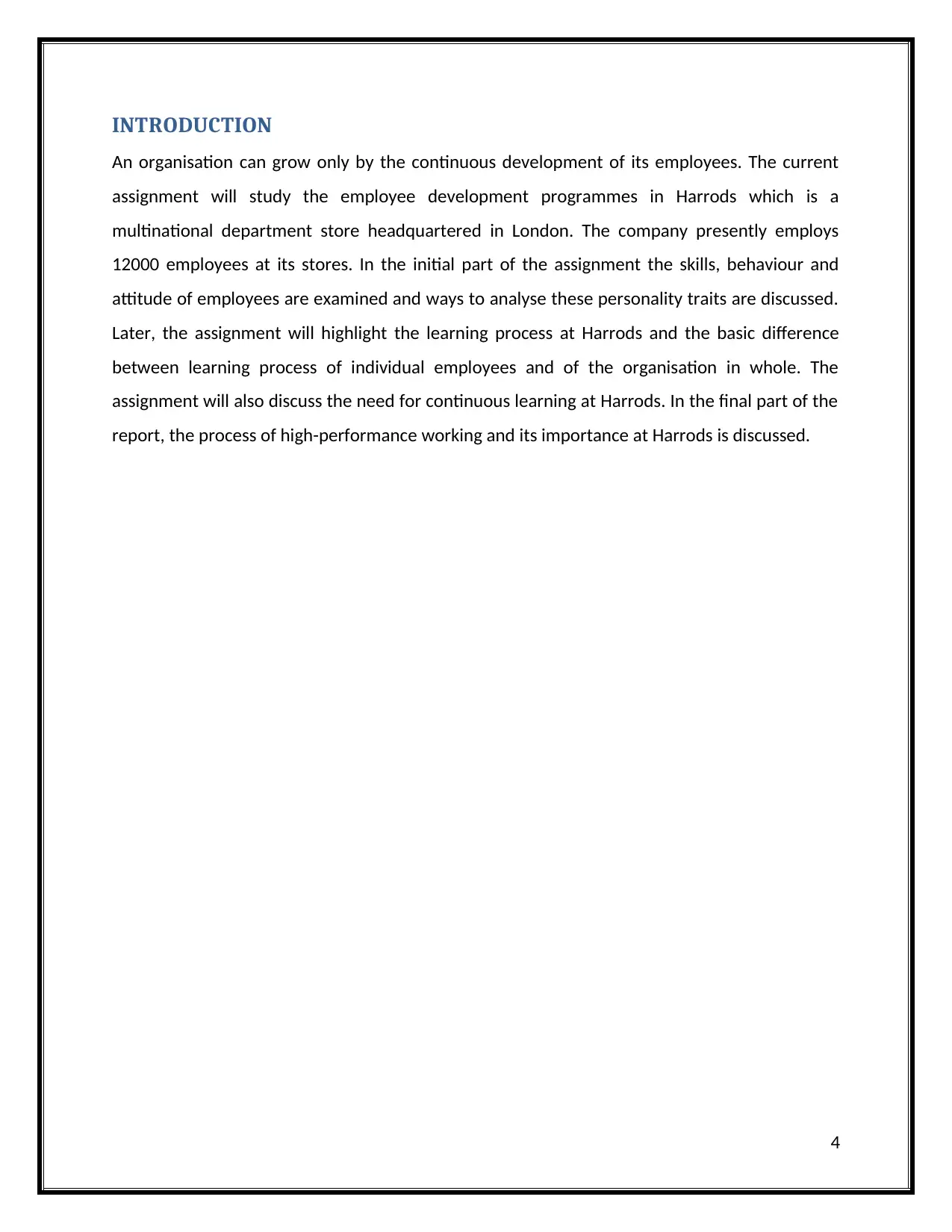
INTRODUCTION
An organisation can grow only by the continuous development of its employees. The current
assignment will study the employee development programmes in Harrods which is a
multinational department store headquartered in London. The company presently employs
12000 employees at its stores. In the initial part of the assignment the skills, behaviour and
attitude of employees are examined and ways to analyse these personality traits are discussed.
Later, the assignment will highlight the learning process at Harrods and the basic difference
between learning process of individual employees and of the organisation in whole. The
assignment will also discuss the need for continuous learning at Harrods. In the final part of the
report, the process of high-performance working and its importance at Harrods is discussed.
4
An organisation can grow only by the continuous development of its employees. The current
assignment will study the employee development programmes in Harrods which is a
multinational department store headquartered in London. The company presently employs
12000 employees at its stores. In the initial part of the assignment the skills, behaviour and
attitude of employees are examined and ways to analyse these personality traits are discussed.
Later, the assignment will highlight the learning process at Harrods and the basic difference
between learning process of individual employees and of the organisation in whole. The
assignment will also discuss the need for continuous learning at Harrods. In the final part of the
report, the process of high-performance working and its importance at Harrods is discussed.
4
Paraphrase This Document
Need a fresh take? Get an instant paraphrase of this document with our AI Paraphraser
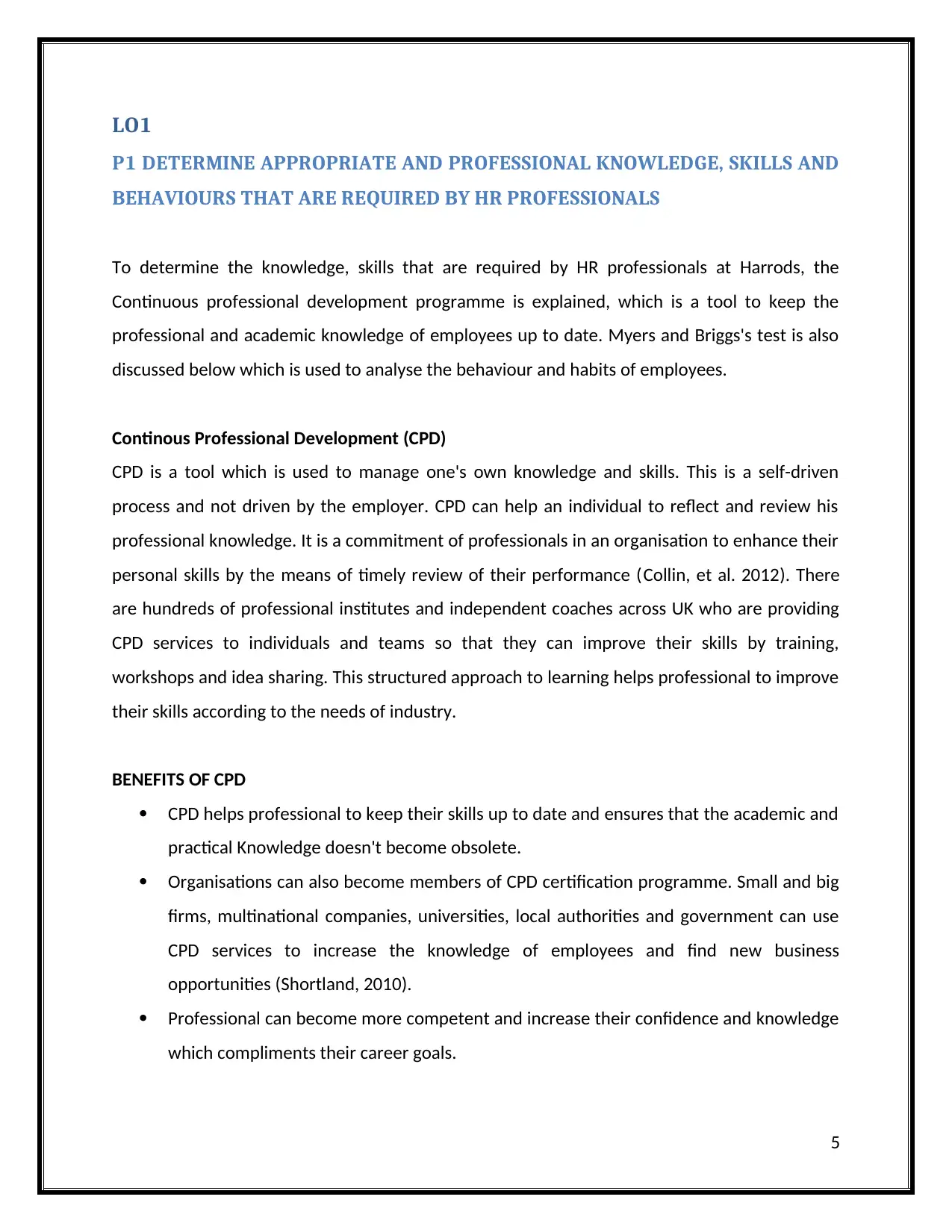
LO1
P1 DETERMINE APPROPRIATE AND PROFESSIONAL KNOWLEDGE, SKILLS AND
BEHAVIOURS THAT ARE REQUIRED BY HR PROFESSIONALS
To determine the knowledge, skills that are required by HR professionals at Harrods, the
Continuous professional development programme is explained, which is a tool to keep the
professional and academic knowledge of employees up to date. Myers and Briggs's test is also
discussed below which is used to analyse the behaviour and habits of employees.
Continous Professional Development (CPD)
CPD is a tool which is used to manage one's own knowledge and skills. This is a self-driven
process and not driven by the employer. CPD can help an individual to reflect and review his
professional knowledge. It is a commitment of professionals in an organisation to enhance their
personal skills by the means of timely review of their performance (Collin, et al. 2012). There
are hundreds of professional institutes and independent coaches across UK who are providing
CPD services to individuals and teams so that they can improve their skills by training,
workshops and idea sharing. This structured approach to learning helps professional to improve
their skills according to the needs of industry.
BENEFITS OF CPD
CPD helps professional to keep their skills up to date and ensures that the academic and
practical Knowledge doesn't become obsolete.
Organisations can also become members of CPD certification programme. Small and big
firms, multinational companies, universities, local authorities and government can use
CPD services to increase the knowledge of employees and find new business
opportunities (Shortland, 2010).
Professional can become more competent and increase their confidence and knowledge
which compliments their career goals.
5
P1 DETERMINE APPROPRIATE AND PROFESSIONAL KNOWLEDGE, SKILLS AND
BEHAVIOURS THAT ARE REQUIRED BY HR PROFESSIONALS
To determine the knowledge, skills that are required by HR professionals at Harrods, the
Continuous professional development programme is explained, which is a tool to keep the
professional and academic knowledge of employees up to date. Myers and Briggs's test is also
discussed below which is used to analyse the behaviour and habits of employees.
Continous Professional Development (CPD)
CPD is a tool which is used to manage one's own knowledge and skills. This is a self-driven
process and not driven by the employer. CPD can help an individual to reflect and review his
professional knowledge. It is a commitment of professionals in an organisation to enhance their
personal skills by the means of timely review of their performance (Collin, et al. 2012). There
are hundreds of professional institutes and independent coaches across UK who are providing
CPD services to individuals and teams so that they can improve their skills by training,
workshops and idea sharing. This structured approach to learning helps professional to improve
their skills according to the needs of industry.
BENEFITS OF CPD
CPD helps professional to keep their skills up to date and ensures that the academic and
practical Knowledge doesn't become obsolete.
Organisations can also become members of CPD certification programme. Small and big
firms, multinational companies, universities, local authorities and government can use
CPD services to increase the knowledge of employees and find new business
opportunities (Shortland, 2010).
Professional can become more competent and increase their confidence and knowledge
which compliments their career goals.
5
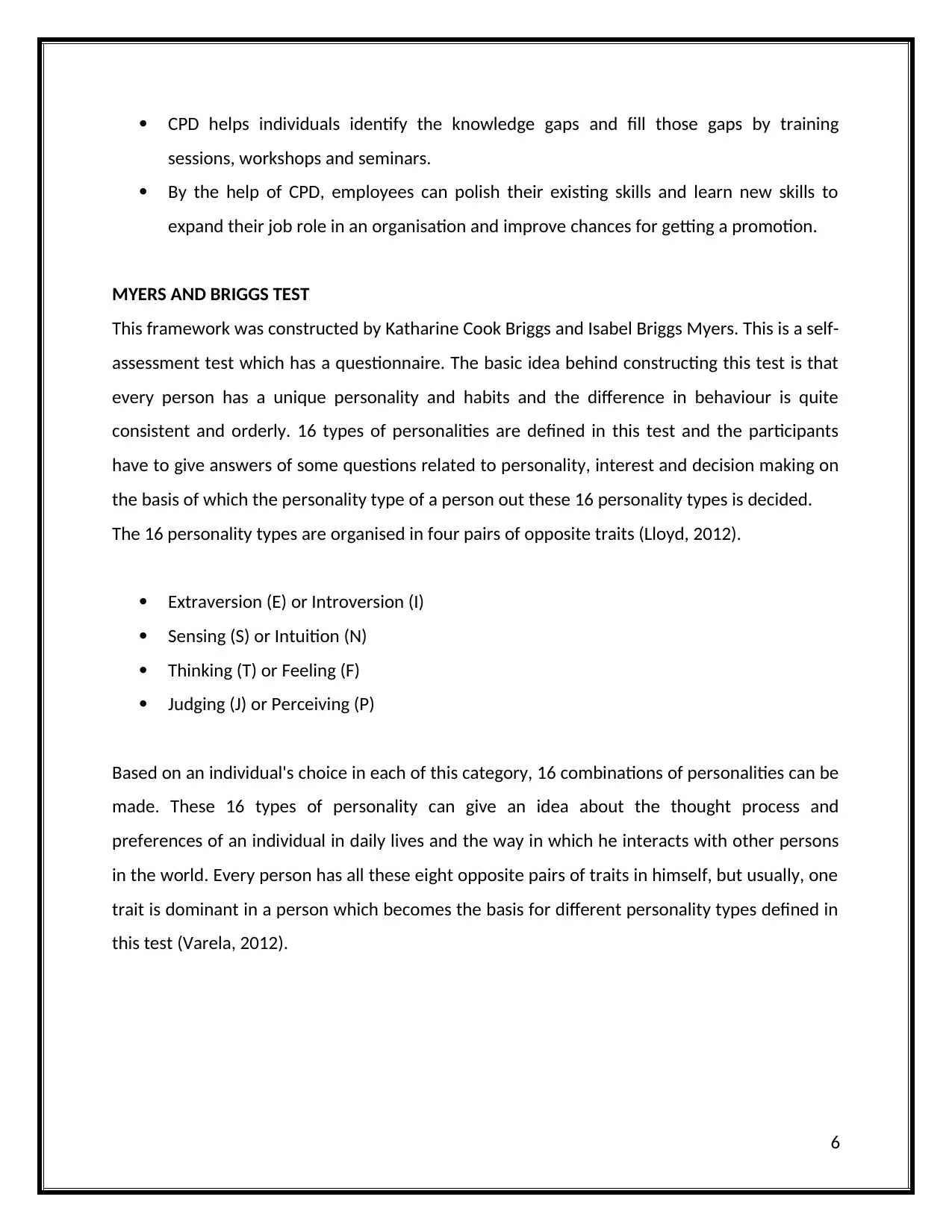
CPD helps individuals identify the knowledge gaps and fill those gaps by training
sessions, workshops and seminars.
By the help of CPD, employees can polish their existing skills and learn new skills to
expand their job role in an organisation and improve chances for getting a promotion.
MYERS AND BRIGGS TEST
This framework was constructed by Katharine Cook Briggs and Isabel Briggs Myers. This is a self-
assessment test which has a questionnaire. The basic idea behind constructing this test is that
every person has a unique personality and habits and the difference in behaviour is quite
consistent and orderly. 16 types of personalities are defined in this test and the participants
have to give answers of some questions related to personality, interest and decision making on
the basis of which the personality type of a person out these 16 personality types is decided.
The 16 personality types are organised in four pairs of opposite traits (Lloyd, 2012).
Extraversion (E) or Introversion (I)
Sensing (S) or Intuition (N)
Thinking (T) or Feeling (F)
Judging (J) or Perceiving (P)
Based on an individual's choice in each of this category, 16 combinations of personalities can be
made. These 16 types of personality can give an idea about the thought process and
preferences of an individual in daily lives and the way in which he interacts with other persons
in the world. Every person has all these eight opposite pairs of traits in himself, but usually, one
trait is dominant in a person which becomes the basis for different personality types defined in
this test (Varela, 2012).
6
sessions, workshops and seminars.
By the help of CPD, employees can polish their existing skills and learn new skills to
expand their job role in an organisation and improve chances for getting a promotion.
MYERS AND BRIGGS TEST
This framework was constructed by Katharine Cook Briggs and Isabel Briggs Myers. This is a self-
assessment test which has a questionnaire. The basic idea behind constructing this test is that
every person has a unique personality and habits and the difference in behaviour is quite
consistent and orderly. 16 types of personalities are defined in this test and the participants
have to give answers of some questions related to personality, interest and decision making on
the basis of which the personality type of a person out these 16 personality types is decided.
The 16 personality types are organised in four pairs of opposite traits (Lloyd, 2012).
Extraversion (E) or Introversion (I)
Sensing (S) or Intuition (N)
Thinking (T) or Feeling (F)
Judging (J) or Perceiving (P)
Based on an individual's choice in each of this category, 16 combinations of personalities can be
made. These 16 types of personality can give an idea about the thought process and
preferences of an individual in daily lives and the way in which he interacts with other persons
in the world. Every person has all these eight opposite pairs of traits in himself, but usually, one
trait is dominant in a person which becomes the basis for different personality types defined in
this test (Varela, 2012).
6
⊘ This is a preview!⊘
Do you want full access?
Subscribe today to unlock all pages.

Trusted by 1+ million students worldwide
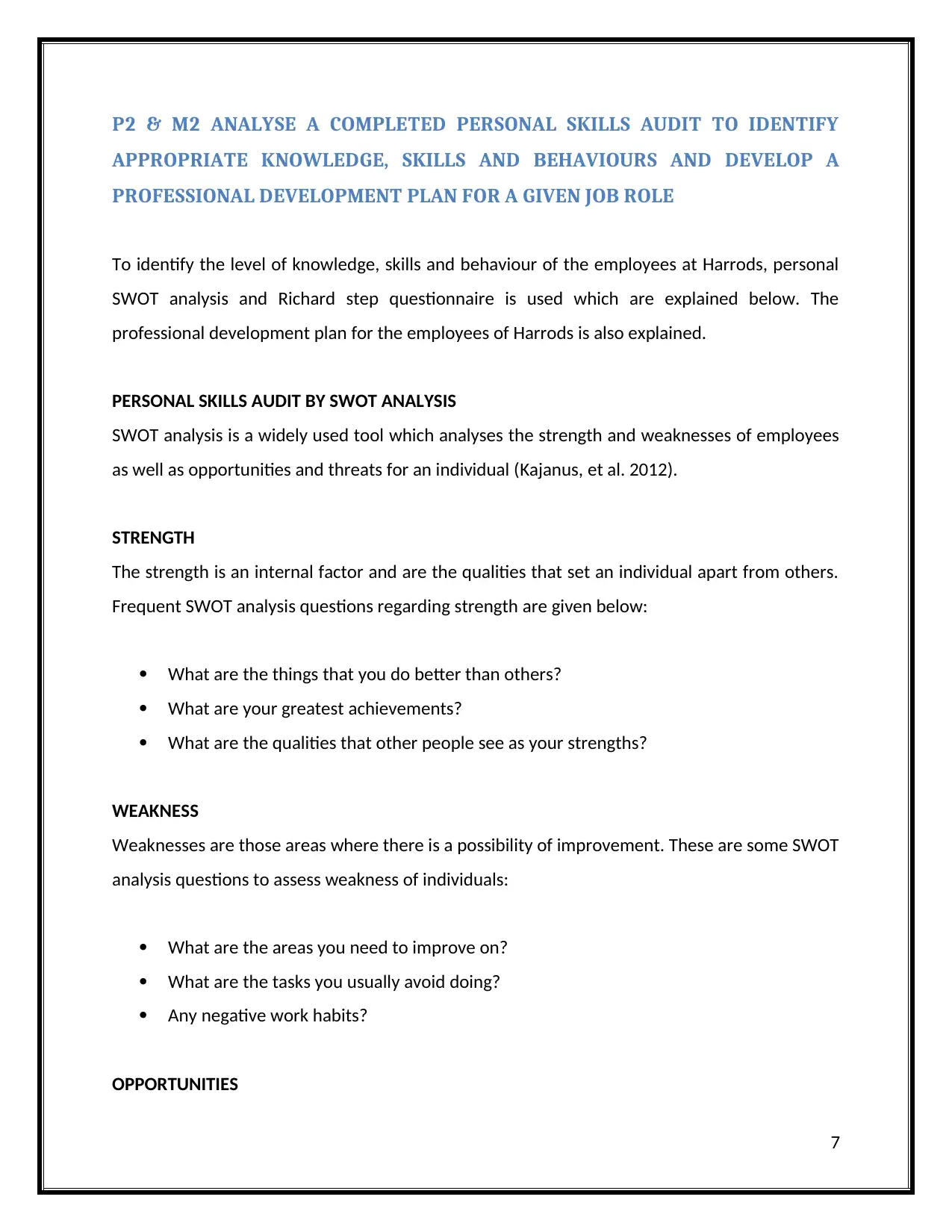
P2 & M2 ANALYSE A COMPLETED PERSONAL SKILLS AUDIT TO IDENTIFY
APPROPRIATE KNOWLEDGE, SKILLS AND BEHAVIOURS AND DEVELOP A
PROFESSIONAL DEVELOPMENT PLAN FOR A GIVEN JOB ROLE
To identify the level of knowledge, skills and behaviour of the employees at Harrods, personal
SWOT analysis and Richard step questionnaire is used which are explained below. The
professional development plan for the employees of Harrods is also explained.
PERSONAL SKILLS AUDIT BY SWOT ANALYSIS
SWOT analysis is a widely used tool which analyses the strength and weaknesses of employees
as well as opportunities and threats for an individual (Kajanus, et al. 2012).
STRENGTH
The strength is an internal factor and are the qualities that set an individual apart from others.
Frequent SWOT analysis questions regarding strength are given below:
What are the things that you do better than others?
What are your greatest achievements?
What are the qualities that other people see as your strengths?
WEAKNESS
Weaknesses are those areas where there is a possibility of improvement. These are some SWOT
analysis questions to assess weakness of individuals:
What are the areas you need to improve on?
What are the tasks you usually avoid doing?
Any negative work habits?
OPPORTUNITIES
7
APPROPRIATE KNOWLEDGE, SKILLS AND BEHAVIOURS AND DEVELOP A
PROFESSIONAL DEVELOPMENT PLAN FOR A GIVEN JOB ROLE
To identify the level of knowledge, skills and behaviour of the employees at Harrods, personal
SWOT analysis and Richard step questionnaire is used which are explained below. The
professional development plan for the employees of Harrods is also explained.
PERSONAL SKILLS AUDIT BY SWOT ANALYSIS
SWOT analysis is a widely used tool which analyses the strength and weaknesses of employees
as well as opportunities and threats for an individual (Kajanus, et al. 2012).
STRENGTH
The strength is an internal factor and are the qualities that set an individual apart from others.
Frequent SWOT analysis questions regarding strength are given below:
What are the things that you do better than others?
What are your greatest achievements?
What are the qualities that other people see as your strengths?
WEAKNESS
Weaknesses are those areas where there is a possibility of improvement. These are some SWOT
analysis questions to assess weakness of individuals:
What are the areas you need to improve on?
What are the tasks you usually avoid doing?
Any negative work habits?
OPPORTUNITIES
7
Paraphrase This Document
Need a fresh take? Get an instant paraphrase of this document with our AI Paraphraser
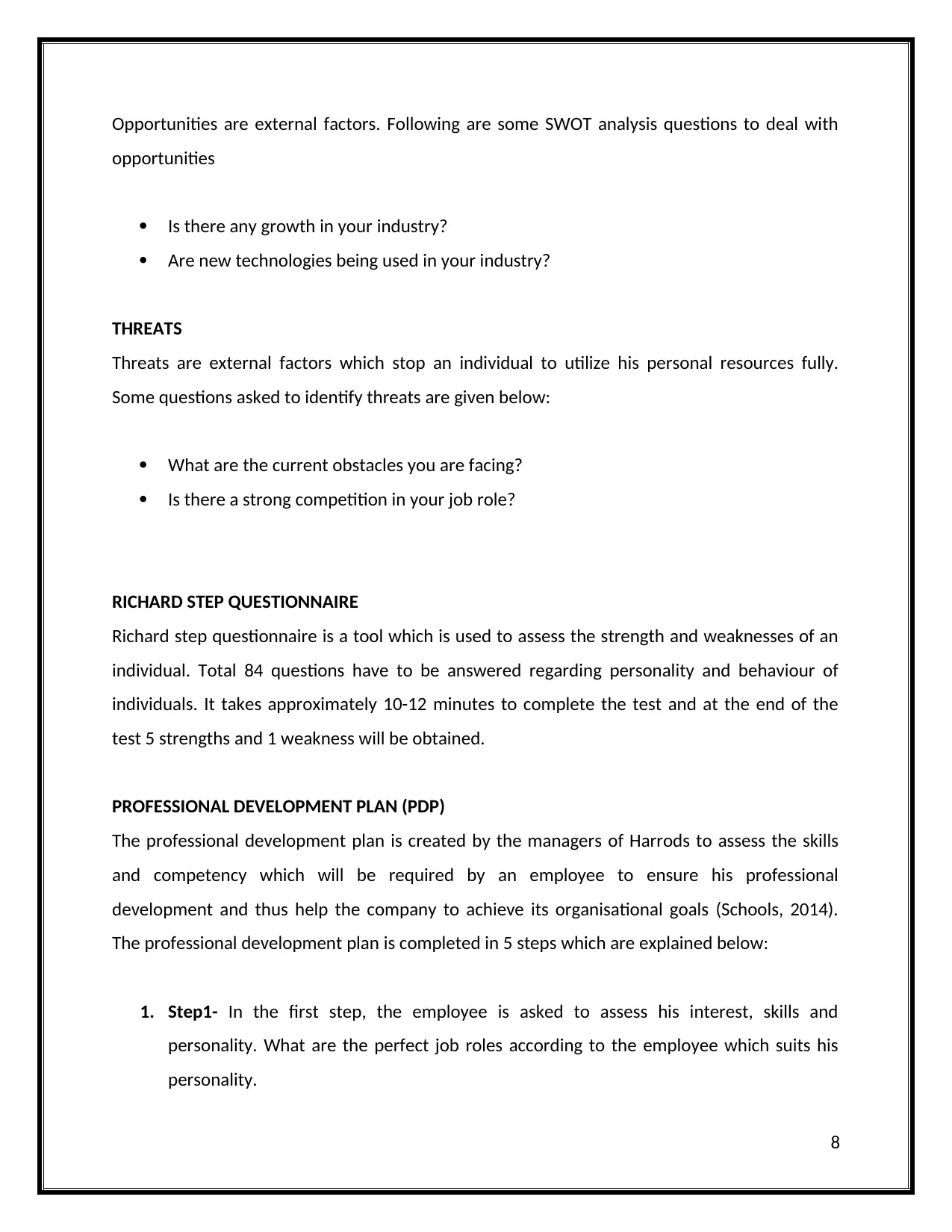
Opportunities are external factors. Following are some SWOT analysis questions to deal with
opportunities
Is there any growth in your industry?
Are new technologies being used in your industry?
THREATS
Threats are external factors which stop an individual to utilize his personal resources fully.
Some questions asked to identify threats are given below:
What are the current obstacles you are facing?
Is there a strong competition in your job role?
RICHARD STEP QUESTIONNAIRE
Richard step questionnaire is a tool which is used to assess the strength and weaknesses of an
individual. Total 84 questions have to be answered regarding personality and behaviour of
individuals. It takes approximately 10-12 minutes to complete the test and at the end of the
test 5 strengths and 1 weakness will be obtained.
PROFESSIONAL DEVELOPMENT PLAN (PDP)
The professional development plan is created by the managers of Harrods to assess the skills
and competency which will be required by an employee to ensure his professional
development and thus help the company to achieve its organisational goals (Schools, 2014).
The professional development plan is completed in 5 steps which are explained below:
1. Step1- In the first step, the employee is asked to assess his interest, skills and
personality. What are the perfect job roles according to the employee which suits his
personality.
8
opportunities
Is there any growth in your industry?
Are new technologies being used in your industry?
THREATS
Threats are external factors which stop an individual to utilize his personal resources fully.
Some questions asked to identify threats are given below:
What are the current obstacles you are facing?
Is there a strong competition in your job role?
RICHARD STEP QUESTIONNAIRE
Richard step questionnaire is a tool which is used to assess the strength and weaknesses of an
individual. Total 84 questions have to be answered regarding personality and behaviour of
individuals. It takes approximately 10-12 minutes to complete the test and at the end of the
test 5 strengths and 1 weakness will be obtained.
PROFESSIONAL DEVELOPMENT PLAN (PDP)
The professional development plan is created by the managers of Harrods to assess the skills
and competency which will be required by an employee to ensure his professional
development and thus help the company to achieve its organisational goals (Schools, 2014).
The professional development plan is completed in 5 steps which are explained below:
1. Step1- In the first step, the employee is asked to assess his interest, skills and
personality. What are the perfect job roles according to the employee which suits his
personality.
8
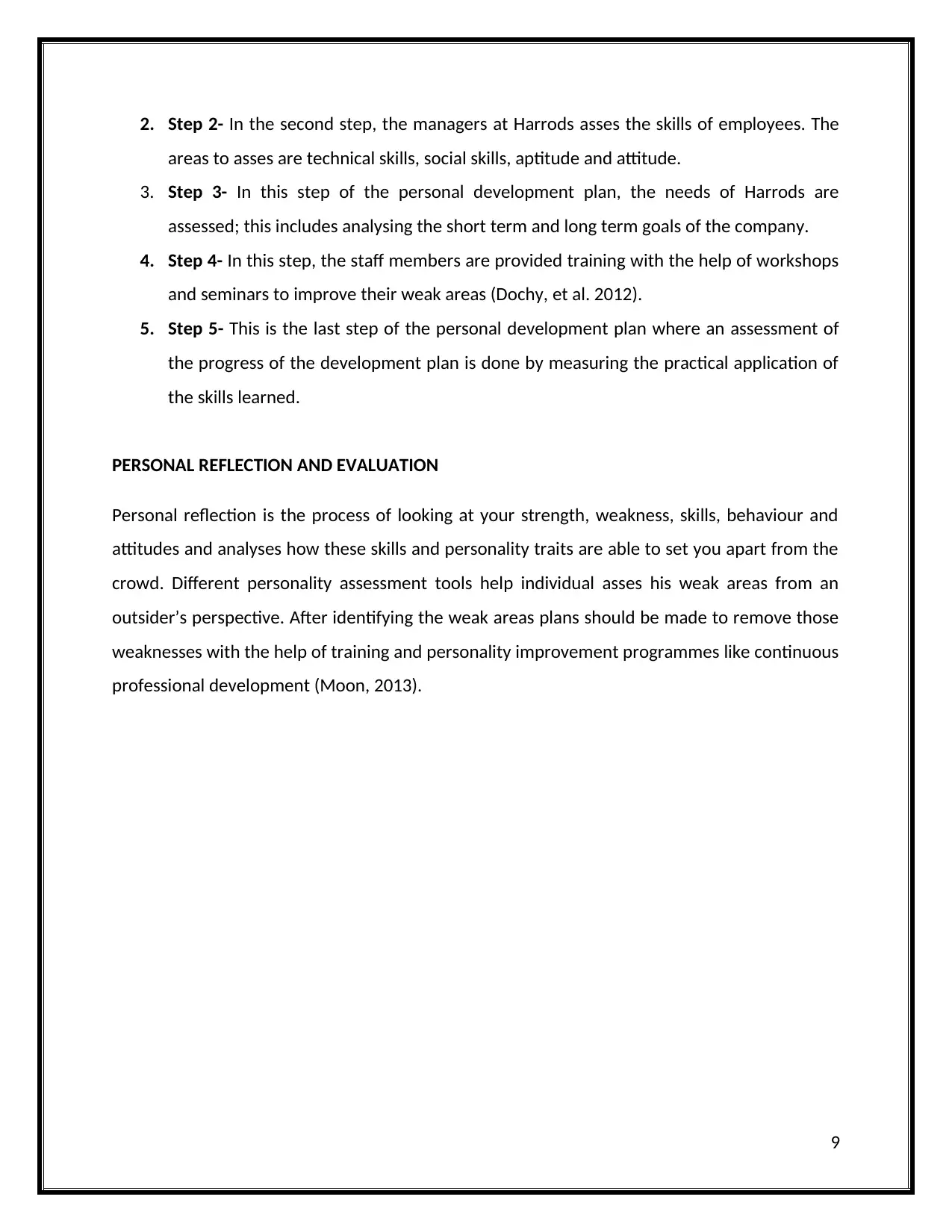
2. Step 2- In the second step, the managers at Harrods asses the skills of employees. The
areas to asses are technical skills, social skills, aptitude and attitude.
3. Step 3- In this step of the personal development plan, the needs of Harrods are
assessed; this includes analysing the short term and long term goals of the company.
4. Step 4- In this step, the staff members are provided training with the help of workshops
and seminars to improve their weak areas (Dochy, et al. 2012).
5. Step 5- This is the last step of the personal development plan where an assessment of
the progress of the development plan is done by measuring the practical application of
the skills learned.
PERSONAL REFLECTION AND EVALUATION
Personal reflection is the process of looking at your strength, weakness, skills, behaviour and
attitudes and analyses how these skills and personality traits are able to set you apart from the
crowd. Different personality assessment tools help individual asses his weak areas from an
outsider’s perspective. After identifying the weak areas plans should be made to remove those
weaknesses with the help of training and personality improvement programmes like continuous
professional development (Moon, 2013).
9
areas to asses are technical skills, social skills, aptitude and attitude.
3. Step 3- In this step of the personal development plan, the needs of Harrods are
assessed; this includes analysing the short term and long term goals of the company.
4. Step 4- In this step, the staff members are provided training with the help of workshops
and seminars to improve their weak areas (Dochy, et al. 2012).
5. Step 5- This is the last step of the personal development plan where an assessment of
the progress of the development plan is done by measuring the practical application of
the skills learned.
PERSONAL REFLECTION AND EVALUATION
Personal reflection is the process of looking at your strength, weakness, skills, behaviour and
attitudes and analyses how these skills and personality traits are able to set you apart from the
crowd. Different personality assessment tools help individual asses his weak areas from an
outsider’s perspective. After identifying the weak areas plans should be made to remove those
weaknesses with the help of training and personality improvement programmes like continuous
professional development (Moon, 2013).
9
⊘ This is a preview!⊘
Do you want full access?
Subscribe today to unlock all pages.

Trusted by 1+ million students worldwide
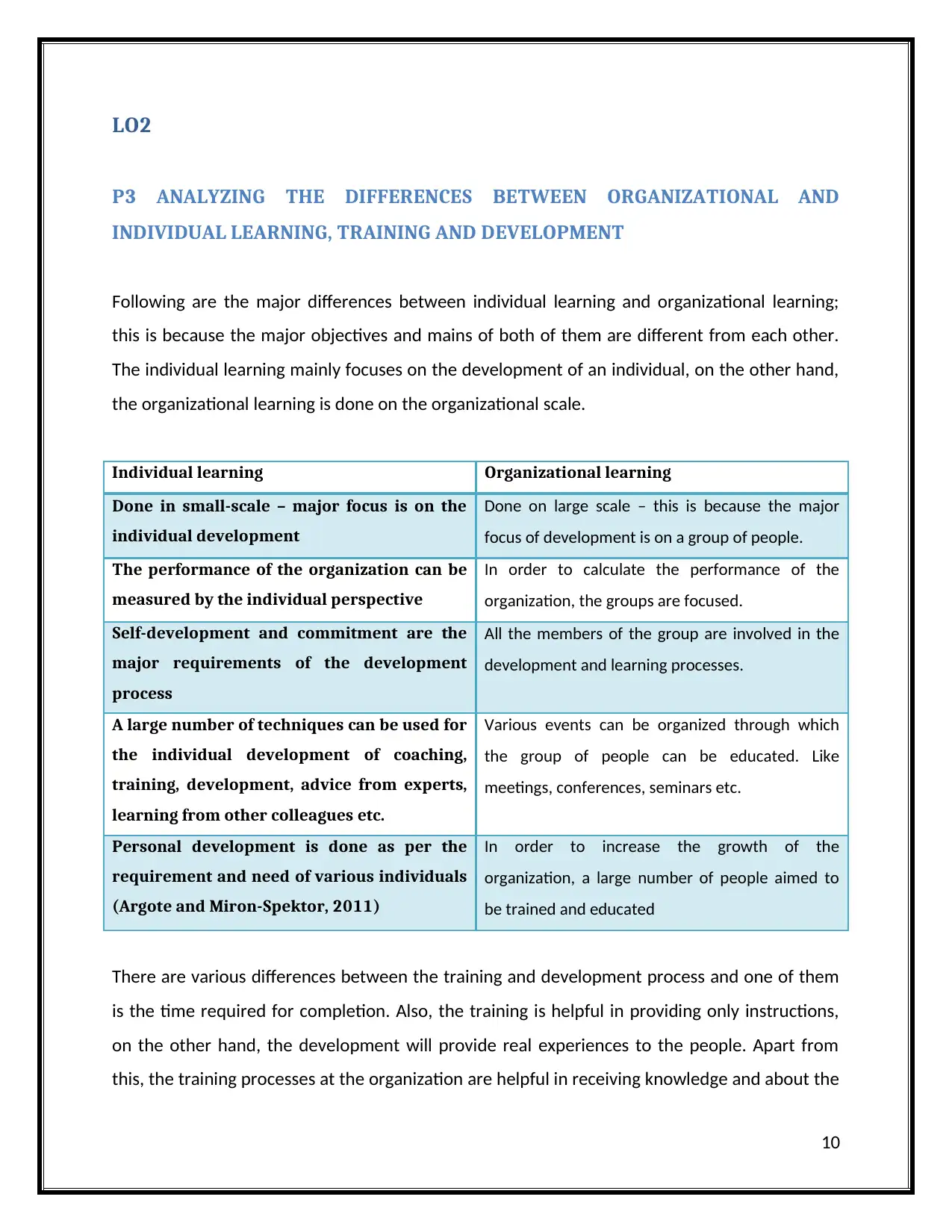
LO2
P3 ANALYZING THE DIFFERENCES BETWEEN ORGANIZATIONAL AND
INDIVIDUAL LEARNING, TRAINING AND DEVELOPMENT
Following are the major differences between individual learning and organizational learning;
this is because the major objectives and mains of both of them are different from each other.
The individual learning mainly focuses on the development of an individual, on the other hand,
the organizational learning is done on the organizational scale.
Individual learning Organizational learning
Done in small-scale – major focus is on the
individual development
Done on large scale – this is because the major
focus of development is on a group of people.
The performance of the organization can be
measured by the individual perspective
In order to calculate the performance of the
organization, the groups are focused.
Self-development and commitment are the
major requirements of the development
process
All the members of the group are involved in the
development and learning processes.
A large number of techniques can be used for
the individual development of coaching,
training, development, advice from experts,
learning from other colleagues etc.
Various events can be organized through which
the group of people can be educated. Like
meetings, conferences, seminars etc.
Personal development is done as per the
requirement and need of various individuals
(Argote and Miron-Spektor, 2011)
In order to increase the growth of the
organization, a large number of people aimed to
be trained and educated
There are various differences between the training and development process and one of them
is the time required for completion. Also, the training is helpful in providing only instructions,
on the other hand, the development will provide real experiences to the people. Apart from
this, the training processes at the organization are helpful in receiving knowledge and about the
10
P3 ANALYZING THE DIFFERENCES BETWEEN ORGANIZATIONAL AND
INDIVIDUAL LEARNING, TRAINING AND DEVELOPMENT
Following are the major differences between individual learning and organizational learning;
this is because the major objectives and mains of both of them are different from each other.
The individual learning mainly focuses on the development of an individual, on the other hand,
the organizational learning is done on the organizational scale.
Individual learning Organizational learning
Done in small-scale – major focus is on the
individual development
Done on large scale – this is because the major
focus of development is on a group of people.
The performance of the organization can be
measured by the individual perspective
In order to calculate the performance of the
organization, the groups are focused.
Self-development and commitment are the
major requirements of the development
process
All the members of the group are involved in the
development and learning processes.
A large number of techniques can be used for
the individual development of coaching,
training, development, advice from experts,
learning from other colleagues etc.
Various events can be organized through which
the group of people can be educated. Like
meetings, conferences, seminars etc.
Personal development is done as per the
requirement and need of various individuals
(Argote and Miron-Spektor, 2011)
In order to increase the growth of the
organization, a large number of people aimed to
be trained and educated
There are various differences between the training and development process and one of them
is the time required for completion. Also, the training is helpful in providing only instructions,
on the other hand, the development will provide real experiences to the people. Apart from
this, the training processes at the organization are helpful in receiving knowledge and about the
10
Paraphrase This Document
Need a fresh take? Get an instant paraphrase of this document with our AI Paraphraser
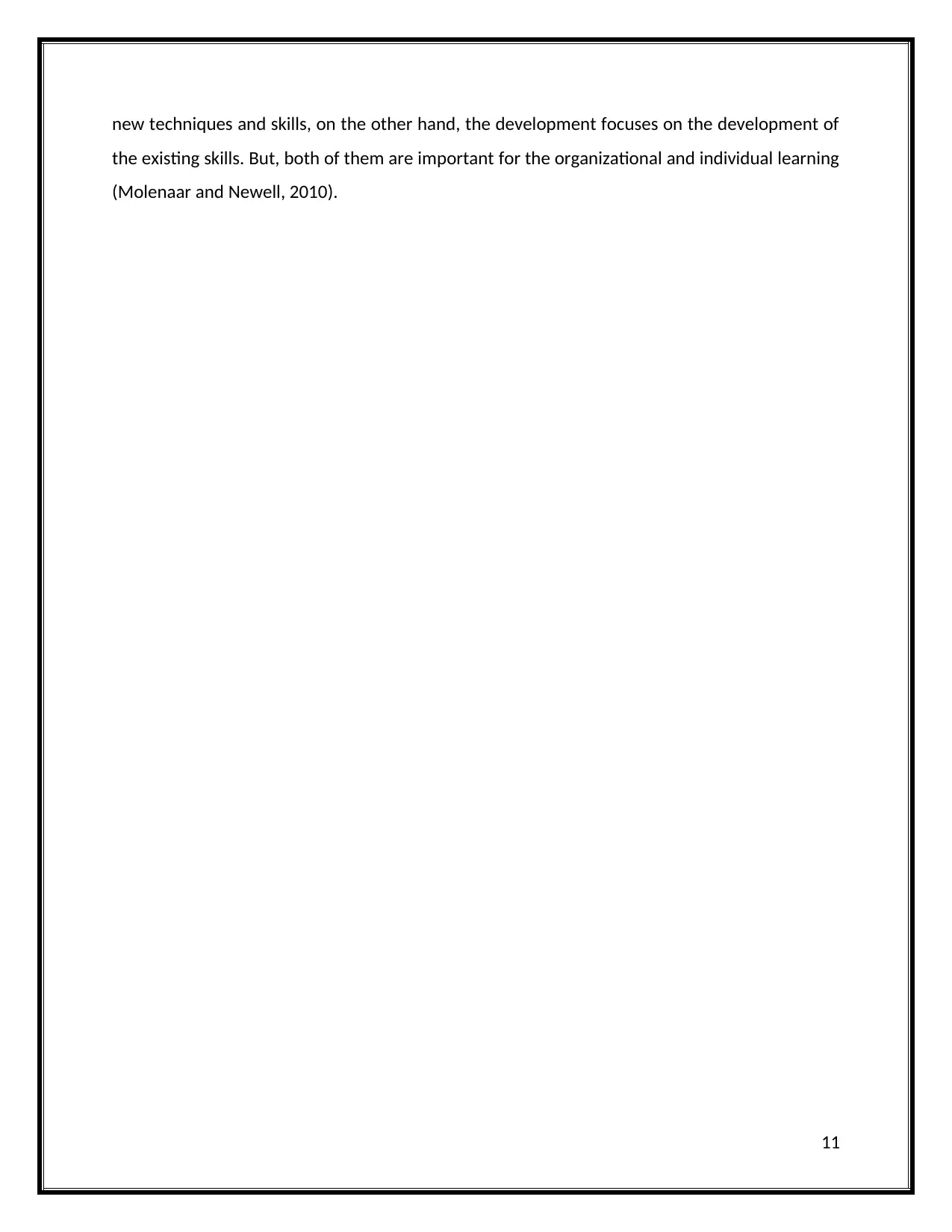
new techniques and skills, on the other hand, the development focuses on the development of
the existing skills. But, both of them are important for the organizational and individual learning
(Molenaar and Newell, 2010).
11
the existing skills. But, both of them are important for the organizational and individual learning
(Molenaar and Newell, 2010).
11
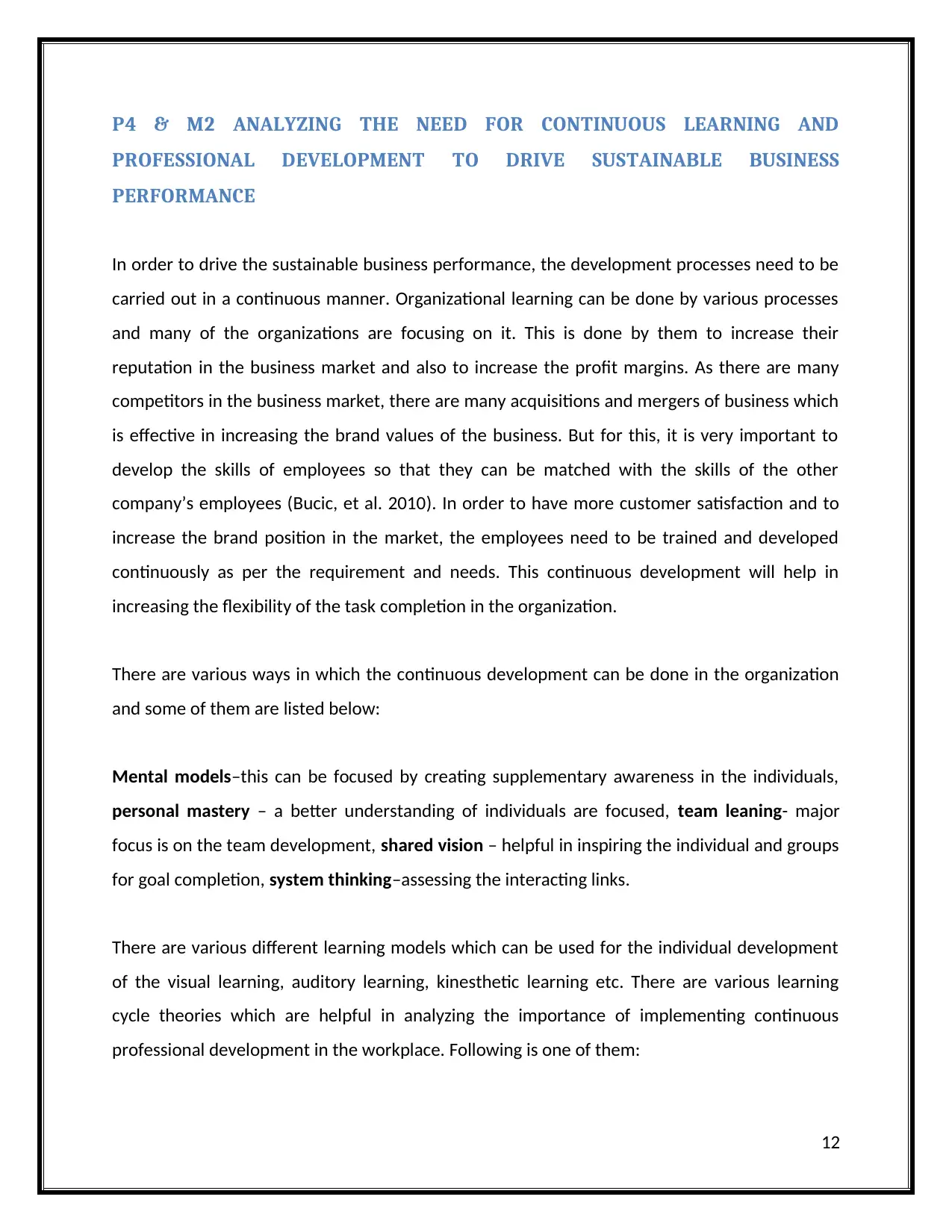
P4 & M2 ANALYZING THE NEED FOR CONTINUOUS LEARNING AND
PROFESSIONAL DEVELOPMENT TO DRIVE SUSTAINABLE BUSINESS
PERFORMANCE
In order to drive the sustainable business performance, the development processes need to be
carried out in a continuous manner. Organizational learning can be done by various processes
and many of the organizations are focusing on it. This is done by them to increase their
reputation in the business market and also to increase the profit margins. As there are many
competitors in the business market, there are many acquisitions and mergers of business which
is effective in increasing the brand values of the business. But for this, it is very important to
develop the skills of employees so that they can be matched with the skills of the other
company’s employees (Bucic, et al. 2010). In order to have more customer satisfaction and to
increase the brand position in the market, the employees need to be trained and developed
continuously as per the requirement and needs. This continuous development will help in
increasing the flexibility of the task completion in the organization.
There are various ways in which the continuous development can be done in the organization
and some of them are listed below:
Mental models–this can be focused by creating supplementary awareness in the individuals,
personal mastery – a better understanding of individuals are focused, team leaning- major
focus is on the team development, shared vision – helpful in inspiring the individual and groups
for goal completion, system thinking–assessing the interacting links.
There are various different learning models which can be used for the individual development
of the visual learning, auditory learning, kinesthetic learning etc. There are various learning
cycle theories which are helpful in analyzing the importance of implementing continuous
professional development in the workplace. Following is one of them:
12
PROFESSIONAL DEVELOPMENT TO DRIVE SUSTAINABLE BUSINESS
PERFORMANCE
In order to drive the sustainable business performance, the development processes need to be
carried out in a continuous manner. Organizational learning can be done by various processes
and many of the organizations are focusing on it. This is done by them to increase their
reputation in the business market and also to increase the profit margins. As there are many
competitors in the business market, there are many acquisitions and mergers of business which
is effective in increasing the brand values of the business. But for this, it is very important to
develop the skills of employees so that they can be matched with the skills of the other
company’s employees (Bucic, et al. 2010). In order to have more customer satisfaction and to
increase the brand position in the market, the employees need to be trained and developed
continuously as per the requirement and needs. This continuous development will help in
increasing the flexibility of the task completion in the organization.
There are various ways in which the continuous development can be done in the organization
and some of them are listed below:
Mental models–this can be focused by creating supplementary awareness in the individuals,
personal mastery – a better understanding of individuals are focused, team leaning- major
focus is on the team development, shared vision – helpful in inspiring the individual and groups
for goal completion, system thinking–assessing the interacting links.
There are various different learning models which can be used for the individual development
of the visual learning, auditory learning, kinesthetic learning etc. There are various learning
cycle theories which are helpful in analyzing the importance of implementing continuous
professional development in the workplace. Following is one of them:
12
⊘ This is a preview!⊘
Do you want full access?
Subscribe today to unlock all pages.

Trusted by 1+ million students worldwide
1 out of 26
Related Documents
Your All-in-One AI-Powered Toolkit for Academic Success.
+13062052269
info@desklib.com
Available 24*7 on WhatsApp / Email
![[object Object]](/_next/static/media/star-bottom.7253800d.svg)
Unlock your academic potential
Copyright © 2020–2025 A2Z Services. All Rights Reserved. Developed and managed by ZUCOL.


